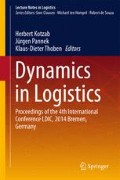Abstract
In this paper, we propose a framework for modeling of logistic systems with an emphasis on model transformation. Due to the complexity of logistic systems, their models are bound to consist of many heterogeneous components on various descriptive levels from the requirement definition to the platform-specific implementation. To cover these phenomena in a comprehensive way, our approach provides two main concepts: First, we introduce logistic models that may be the combination of a variety of component models, which in turn may be of different types, i.e., they may be specified by means of different modeling methods. Second, we offer model transformations that allow to translate logistic models of one type into logistic models of another type whenever needed (for example, to bridge the gap between visual platform-independent models and textual platform-specific models or to facilitate the interaction of component models of different types).
Access this chapter
Tax calculation will be finalised at checkout
Purchases are for personal use only
References
Barnhart C, Laporte G (2006) Handbooks in operations research and management science: transportation. Elsevier Science and Technology, Amsterdam
Broy M (2010) Cyber-physical systems: innovation durch softwareintensive eingebettete Systeme. Springer, Berlin
Hee K, Sidorova N, Werf J (2013) Business process modeling using petri nets. In: Jensen K, van der Aalst WMP, Balbo G, Koutny M, Wolf K (eds) Transactions on petri nets and other models of concurrency lecture, Notes in Computer Science 7480:116–161
Hülsmann M, Windt K (2007) Understanding of autonomous cooperation and control in logistics—the impact of autonomy on management, information, communication and material flow. Springer, Berlin
Hülsmann M, Scholz-Reiter B, Windt K (2011) Autonomous cooperation and control in logistics. Springer, Berlin
Kreowski H-J, Kuske S (2013) Graph tuple transformation. Electronic Communications of the EASST 62, 23 pages
Kreowski H-J, Kuske S, von Totth C (2010) Stepping from graph transformation units to model transformation units. Electronic Communications of the EASST 30, 24 pages
Kreowski H-J, Kuske S, von Totth C (2012) Combining graph transformation and algebraic specification into model transformation. In: Mossakowski T, Kreowski H-J (eds) Proceedings of the international workshop on algebraic development techniques (WADT 2010) Lecture Notes in Computer Science, vol 7137. pp 193–208
Laguna M, Marklund J (2004) Business process modeling, simulation, and design. Pearson/Prentice Hall, New Jersey
NSF National Science Foundation (2008) Cyber-physical systems. Program announcements and information. NSF 08–11, http://www.nsf.gov/publications/pub_summ.jsp?ods_key=nsf08611. Accessed 16 Oct 2013
OMG Object Management Group (2013) Business process model and notation (BPMN), http://www.omg.org/spec/BPMV/2.02/pdf. Accessed 10 Mar 2013
Recker JC (2006) Process modeling in the 21st century. BP Trend, pp 1–6
Scholz-Reiter B, Rippel D, Sowade S (2011a) Limitations in modeling autonomous logistic processes—challenges and solutions in business process modeling. In: Proceedings of the IEEE international symposium on assembly and manufacturing 2011 (ISAM’11). Tampere, USB-Proceedings, 6 pages
Scholz-Reiter B, Sowade S, Rippel D (2011b) Modeling the control system infrastructure for autonomous logistics processes. In: Duffy NA (ed) 44th CIRP conference on manufacturing systems. Omnipress, Madison-Wisconsin, pp 1–6
Van der Aalst W, Stahl C (2011) Modeling business processes: a petri net-oriented approach. Cooperative information systems. MIT Press, Cambridge
Author information
Authors and Affiliations
Corresponding author
Editor information
Editors and Affiliations
Rights and permissions
Copyright information
© 2016 Springer International Publishing Switzerland
About this paper
Cite this paper
Kreowski, HJ., Franke, M., Hribernik, K., Kuske, S., Thoben, KD., von Totth, C. (2016). Toward a Comprehensive Approach to the Transformation of Logistic Models. In: Kotzab, H., Pannek, J., Thoben, KD. (eds) Dynamics in Logistics. Lecture Notes in Logistics. Springer, Cham. https://doi.org/10.1007/978-3-319-23512-7_11
Download citation
DOI: https://doi.org/10.1007/978-3-319-23512-7_11
Published:
Publisher Name: Springer, Cham
Print ISBN: 978-3-319-23511-0
Online ISBN: 978-3-319-23512-7
eBook Packages: EngineeringEngineering (R0)

